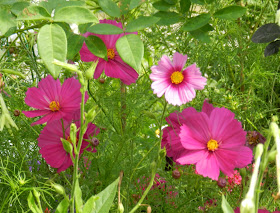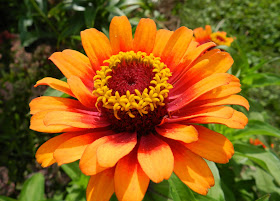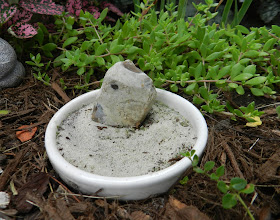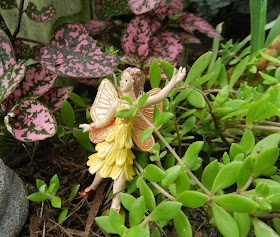I don't remember when I first fell in love with Japanese gardens. What I do remember is wherever and whenever that first experience occurred, something mystical stirred within me, and I felt a sense of peace overcoming me. Thoughts of the outside world left my mind as I sat under lush greenery and listened to the calming sound of water.
I've visited several Japanese gardens, both large and small, since that first experience, and of all of them, the most beautiful one has to be the
Portland Japanese Garden in Oregon, which I've written about
here and
here. Both visits to this enchanted place filled me with serenity and inspiration.
I've longed for some time to create such a tranquil oasis near my own home, but besides the fact that the simple, clean lines of this style wouldn't quite fit my cottage style (a generous use of that term) garden, Japanese gardens require years to establish fully. I would be 90 or 100 years old before I could truly enjoy my own! And so, I've resigned myself to enjoying these gardens on the occasional visit.
That is until now . . .
Voila! Yes, indeed, I finally have my very own Zen garden for quiet contemplation! You must be wondering, "Rose, however did you achieve this in such a short time?" And, "However did you keep this a secret while you planted trees and shrubs and moved boulders into place for a retaining wall??" Before you marvel too much, however, let me say that I always try to be honest with my readers. So let's step back and take a longer look at this garden, shall we?

A different perspective reveals the truth--my Zen retreat is actually a miniature garden! Last summer I decided I really wanted to create a fairy garden this year and finally found what I thought would be the perfect place--under the 'Limelight' hydrangea whose leaves would provide a shady spot for the fairies. I did a little planning and thinking and in the fall purchased a few pieces for the garden after a workshop on fairy gardens at our local garden center. With my granddaughter, I did a "trial run" and used the pieces in a little indoor fairy garden over the winter, which unfortunately had rather
disastrous results.
Undaunted by the indoor failure, this spring my friend Beckie and I headed to the garden center for their annual spring workshops, hoping, too, to snag another coupon for more accessories for the fairy garden. However, what we thought was going to be a workshop specifically on fairy gardens turned out to be one on miniature gardens in general. The garden center had just received a new shipment of various items, and the presenter decided to choose a pagoda and a small Buddha to create her demonstration mini-garden. Suddenly, that proverbial lightbulb went off over my head--if I couldn't have a "real" Japanese garden at home, why not a miniature one?

I snapped up the last remaining pagoda and small Buddha after the workshop; the few pieces I had purchased the previous fall, I realized, would easily fit into an Asian theme just as well as in a fairy home. All that was left to do now was prepare the site and arrange the elements. A few plants had to be moved, including the diminutive 'Minnow' daffodils, which were carefully re-planted to form the northern border next spring. A few large tulips were marked for moving later this fall. At last, I could begin designing the new garden.
A true Japanese garden has three main elements--
stone, water, and plants--all natural materials to emphasize the connection between existing nature and this type of garden. The "stone" pagoda and walkway, the "boulders" in the retaining wall, and the curved bridge, another common sight in these gardens, all fit the first element. The Fu dogs, a gift from friend Beckie, are actually more typical of Chinese architecture, but this is a non-denominational sanctuary, where all beliefs are welcome! They look a little intimidating guarding the curved bridge, but I didn't place them there, as you'll see later.
I remembered the poetry stone I saw in the Portland garden and wanted to add this, too. Nothing suitable could be found in garden centers, so I created my own "monolith." The Portland stone had haiku carved into it, but I didn't think my hand was steady enough to write a whole poem in tiny characters. Instead, the stone simply says "Peace"--or at least I hope that's what it says:)
The second element of a Japanese garden is noticeably missing here for a very practical reason. A miniature
water feature would need constant replenishing, but most importantly, Sophie thinks any element of water--fountains, birdbaths, etc.-- in the garden is her personal drinking dish. This garden may be open to all creeds, but it doesn't need a Golden Retriever trampling through it:)
Instead of water, I created a dry stream flowing under the bridge made from aquarium gravel--a cheap alternative to anything labeled "miniature gardening." The traditional dry garden, which many of us lay people refer to as a Zen garden, mimics the sea as well. I puzzled over how to keep the sand intact for some time until I found a castoff ramekin once used as a food dish for a long since departed pet turtle. Clearly, the Zen garden needs some raking, which it will as soon as I remember where I put the miniature rake:)
Finally, the third main element of a Japanese garden--the
plants. A traditional garden has a primarily monochromatic color scheme, using lots of evergreens. Several of our local garden centers now carry a small selection of dwarf conifers, but they're pretty pricey. Not knowing how they might fare through our winters, I've only purchased one--a false cypress, one of my favorites, seen next to the monolith in an earlier photo. After the first one died and I had to replace it, the purse strings got even tighter, and I opted for a cheaper alternative to a tall conifer. The Lemon Cypress above is not a winter-hardy perennial, so I left it in its pot and will bring it in for the winter. If it doesn't survive, it can easily be replaced next spring without spending much money.

The miniature hosta 'Pooh Bear' was already in the garden, so it only needed to be moved to this more appropriate spot. Other plants in the garden include another miniature hosta, a small trailing veronica, Sedum 'Angelina,' and some annuals including a thyme and the polka-dot plant seen in earlier photos. I'd really like to cover the whole area with moss, but I suspect it won't do well here unless I make a commitment to watering this area every single day.
In fact, I'm not sure how any of these plants will do over the winter, another reason for the economical plant selection this first year. It will be a true learning experience to see if the pricier perennials survive; if they don't, there are plenty of annuals that will do just fine--I've found herbs like thyme are great choices for a tiny garden. I'm not worried, though, about the miniature iris I dug up from my mother's garden and planted in the south border. They'll be a perfect addition when they bloom next spring.
I'd like to say I created this garden all by myself, but I did have a couple of helpers one evening--my granddaughter and her friend came over to do the heavy lifting of some "boulders" for the retaining wall and building the dry stream. There was some friendly debating as they moved pieces around and decided on just the right spot for the Fu dogs. It always helps to have some extra landscape design advice!
A few days later, I went out to water one morning and was totally surprised to find two new inhabitants in the garden. Perhaps garden fairies aren't always the mischievous, frivolous creatures we think they are; maybe they need a place for quiet contemplation once in awhile, too. How and why they arrived I'm not sure, but they're certainly welcome here--as long as they observe proper decorum. It is a little suspicious, though, that their arrival coincided with a visit from blogging friend
Lisa:)
There is still more tweaking of this garden to be done: I'd like to find a miniature stone lantern and a crane, the Japanese symbol of longevity, and I realized another missing part--a bench big enough for me to sit on! But that's the beauty of a miniature garden compared to the traditional Japanese garden--all elements can easily be changed and will no doubt change from year to year.






































